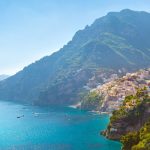
Can’t wait to discover the beaches of Ponza and dive into crystal clear, pristine water? Discover the island’s most beautiful places and natural pools!
Spending your vacation in Ponza and visiting the other Pontine islands is an excellent choice if you want to find breathtaking views, no less stunning than the beaches of Procida or the most beautiful towns on the Amalfi coast.
Which are the Pontine Islands? These islands, which, as the crow flies, are just across the border between Lazio and Campania, are six in number: Gavi and Santo Stefano are the smallest and least touristy; Zannone, the northernmost island, on the other hand, is part of the Circeo National Park because of its naturalistic relevance.
Palmarola is also a nature reserve and is called “La Forcina”: more for its narrow and long shape than for its dense vegetation. It is considered one of the most beautiful islands in the world, both for the variety of its coastline of sandy beaches and rocks, headlands and many small gulfs, as well as its typical rock-carved houses.
Ventotene, on the other hand, is the ideal destination for scuba divers. Its most beautiful attractions are the lava sand seabed and the cave of Punta Pascone, a joy for the eyes for the colors of the walls, the fish and the plays of light arising from the filtered sunlight.

All Ponza’s beaches and rock pools
The largest island, which therefore gives its name to the whole complex, is clearly Ponza. Whether it’s days at the beach, walks along the cliffs, boat rides or diving, you’ll be spoiled for choice of things to do on a weekend in Ponza!
One of the most famous beaches is undoubtedly Frontone Beach. Frontone literally means pediment, observing its white tufa cliff, you’ll understand the origin of the name: its shape and color are vaguely reminiscent of the pediments of Greek temples, with its triangular structure resting on columns. Fronte beach is perfect for relaxing on a Ponza vacation and can be reached either on foot or by sea: taxi-boats or land shuttles depart every quarter of an hour from Ponza’s port, connecting it to the center of the island.

As with all other beaches, the name of Cala Felci betrays one particularity: the fern plants that grow around it and give it that unprecedented, almost wild air. Accessible only by sea, the beach is sand and pebbles and the water is an almost phosphorescent blue, more intense when the basin is bathed by the sun, from about 10.00 am to 3.00 pm. In some places on the shore, however, you may also notice yellow-ochre hues, thanks to the sulfur rocks that tint the water.
On the other hand, the rocks of Cala Gaetano are very white, known mainly for the seabed with its varied flora and fauna and for the approximately three hundred steps that must be climbed to reach the shore. But trust us: it’s a very small effort considering what awaits you!
Cala Inferno is one of Ponza’s most picturesque beaches, now unfortunately closed to the public and in any case accessible only by sea. The origin of the name perhaps conceals the toil of those who varved out and walked the 350 steps of the staircase that connected the sea to the settlement: in fact, this cove was the landing site for goods transiting to and from the port of Ponza.
Cala Feola, on the other hand, is the only entirely sandy beach in Ponza. It is sunny from 9.00 am to 4.00 pm, and there you will discover the beauty of the Natural Pools, or “Fontone”: enclosed hollows, sheltered from the open sea but with equally clear blue water. Swimming in these rock pools will be one of your fondest Ponza vacation memories.

The history and legend of Pilate’s Caves
Perhaps not everyone knows that Pontius Pilate owes his name to the island of Ponza. Before handing Jesus over to the Romans, the young and restless Pilate was sent to Ponza: his family, who probably just wanted to keep him away from Rome, entrusted him with the task of putting down a revolt. He succeeded, and the Pilate’s Caves bear his name to this day – large artificial pools that are a testament to Roman hydraulic engineering skill and used to farm moray eels.

The cave houses of Ponza
Typical of Ponza are also the cave-houses, cave–houses excavated directly in the rock by the island’s first inhabitants. From simple caves, these shelters have become more like real houses. Here rock forms the ceiling, the floor and the main wall. An invaluable historical heritage, as are the Sassi di Matera.

To Ponza with Italo
And now you’re wondering… how to get to Ponza? With trains from Naples of course – more than 40 each day – and the Naples-Ponza ferries! You can choose Ponza as your first stop or to finish off your vacation in style after a short tour of Naples for a few days. Just pack up… and go!








